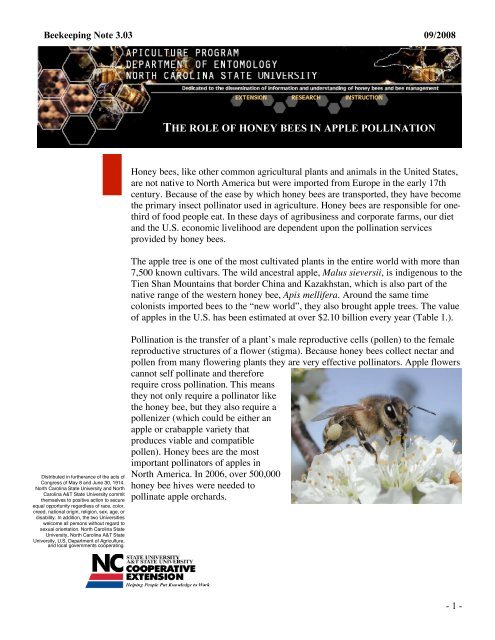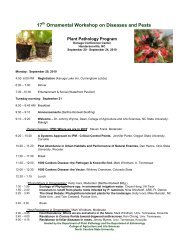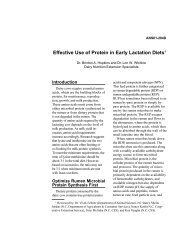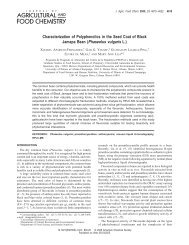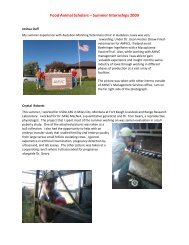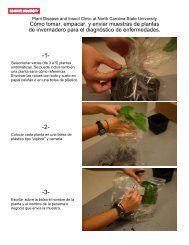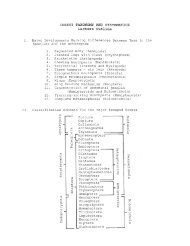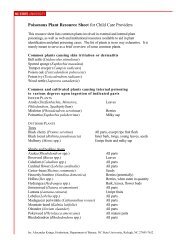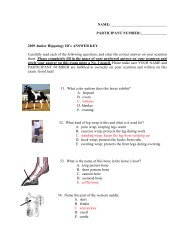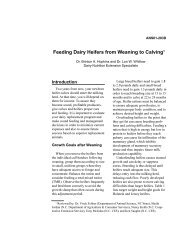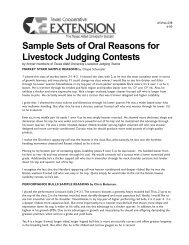the role of honey bees in apple pollination - North Carolina State ...
the role of honey bees in apple pollination - North Carolina State ...
the role of honey bees in apple pollination - North Carolina State ...
Create successful ePaper yourself
Turn your PDF publications into a flip-book with our unique Google optimized e-Paper software.
Beekeep<strong>in</strong>g Note 3.03 09/2008<br />
Distributed <strong>in</strong> fur<strong>the</strong>rance <strong>of</strong> <strong>the</strong> acts <strong>of</strong><br />
Congress <strong>of</strong> May 8 and June 30, 1914.<br />
<strong>North</strong> Carol<strong>in</strong>a <strong>State</strong> University and <strong>North</strong><br />
Carol<strong>in</strong>a A&T <strong>State</strong> University commit<br />
<strong>the</strong>mselves to positive action to secure<br />
equal opportunity regardless <strong>of</strong> race, color,<br />
creed, national orig<strong>in</strong>, religion, sex, age, or<br />
disability. In addition, <strong>the</strong> two Universities<br />
welcome all persons without regard to<br />
sexual orientation. <strong>North</strong> Carol<strong>in</strong>a <strong>State</strong><br />
University, <strong>North</strong> Carol<strong>in</strong>a A&T <strong>State</strong><br />
University, U.S. Department <strong>of</strong> Agriculture,<br />
and local governments cooperat<strong>in</strong>g.<br />
THE ROLE OF HONEY BEES IN APPLE POLLINATION<br />
Honey <strong>bees</strong>, like o<strong>the</strong>r common agricultural plants and animals <strong>in</strong> <strong>the</strong> United <strong>State</strong>s,<br />
are not native to <strong>North</strong> America but were imported from Europe <strong>in</strong> <strong>the</strong> early 17th<br />
century. Because <strong>of</strong> <strong>the</strong> ease by which <strong>honey</strong> <strong>bees</strong> are transported, <strong>the</strong>y have become<br />
<strong>the</strong> primary <strong>in</strong>sect poll<strong>in</strong>ator used <strong>in</strong> agriculture. Honey <strong>bees</strong> are responsible for onethird<br />
<strong>of</strong> food people eat. In <strong>the</strong>se days <strong>of</strong> agribus<strong>in</strong>ess and corporate farms, our diet<br />
and <strong>the</strong> U.S. economic livelihood are dependent upon <strong>the</strong> poll<strong>in</strong>ation services<br />
provided by <strong>honey</strong> <strong>bees</strong>.<br />
The <strong>apple</strong> tree is one <strong>of</strong> <strong>the</strong> most cultivated plants <strong>in</strong> <strong>the</strong> entire world with more than<br />
7,500 known cultivars. The wild ancestral <strong>apple</strong>, Malus sieversii, is <strong>in</strong>digenous to <strong>the</strong><br />
Tien Shan Mounta<strong>in</strong>s that border Ch<strong>in</strong>a and Kazakhstan, which is also part <strong>of</strong> <strong>the</strong><br />
native range <strong>of</strong> <strong>the</strong> western <strong>honey</strong> bee, Apis mellifera. Around <strong>the</strong> same time<br />
colonists imported <strong>bees</strong> to <strong>the</strong> “new world”, <strong>the</strong>y also brought <strong>apple</strong> trees. The value<br />
<strong>of</strong> <strong>apple</strong>s <strong>in</strong> <strong>the</strong> U.S. has been estimated at over $2.10 billion every year (Table 1.).<br />
Poll<strong>in</strong>ation is <strong>the</strong> transfer <strong>of</strong> a plant’s male reproductive cells (pollen) to <strong>the</strong> female<br />
reproductive structures <strong>of</strong> a flower (stigma). Because <strong>honey</strong> <strong>bees</strong> collect nectar and<br />
pollen from many flower<strong>in</strong>g plants <strong>the</strong>y are very effective poll<strong>in</strong>ators. Apple flowers<br />
cannot self poll<strong>in</strong>ate and <strong>the</strong>refore<br />
require cross poll<strong>in</strong>ation. This means<br />
<strong>the</strong>y not only require a poll<strong>in</strong>ator like<br />
<strong>the</strong> <strong>honey</strong> bee, but <strong>the</strong>y also require a<br />
pollenizer (which could be ei<strong>the</strong>r an<br />
<strong>apple</strong> or crab<strong>apple</strong> variety that<br />
produces viable and compatible<br />
pollen). Honey <strong>bees</strong> are <strong>the</strong> most<br />
important poll<strong>in</strong>ators <strong>of</strong> <strong>apple</strong>s <strong>in</strong><br />
<strong>North</strong> America. In 2006, over 500,000<br />
<strong>honey</strong> bee hives were needed to<br />
poll<strong>in</strong>ate <strong>apple</strong> orchards.<br />
- 1 -
Beekeep<strong>in</strong>g Note 3.03 09/2008<br />
Poll<strong>in</strong>ation obstacles<br />
There are many different factors that can result <strong>in</strong><br />
poor poll<strong>in</strong>ation <strong>of</strong> <strong>apple</strong> trees. If <strong>the</strong> poll<strong>in</strong>ator (bee)<br />
population is too small, <strong>the</strong> ‘poll<strong>in</strong>ation threshold’<br />
will not be reached and <strong>the</strong>re will be a lack <strong>of</strong> viable<br />
pollen transferred to receptive flowers. Good<br />
wea<strong>the</strong>r dur<strong>in</strong>g flower bloom is also critical for<br />
optimal poll<strong>in</strong>ation. Honey <strong>bees</strong> tend to visit flowers<br />
<strong>in</strong> <strong>the</strong> morn<strong>in</strong>g. Any disturbance <strong>of</strong> early visitation<br />
times due to wea<strong>the</strong>r, spray schedules, mow<strong>in</strong>g, or<br />
o<strong>the</strong>r management practices may significantly affect<br />
<strong>the</strong> poll<strong>in</strong>ation efforts <strong>of</strong> <strong>honey</strong> <strong>bees</strong> and o<strong>the</strong>r<br />
Gears.tucson.ars.ag.gov/ic/<strong>apple</strong>s/blossom<br />
poll<strong>in</strong>ators. The presence <strong>of</strong> pollen sources or<br />
compatible pollenizer varieties is crucial for <strong>the</strong> successful poll<strong>in</strong>ation <strong>of</strong> <strong>apple</strong> flowers. Below is<br />
a chart that lists <strong>apple</strong> varieties from earliest to latest bloom times, and <strong>the</strong> compatibility <strong>of</strong><br />
varieties as poll<strong>in</strong>izers.<br />
extension.missouri.edu<br />
- 2 -
Beekeep<strong>in</strong>g Note 3.03 09/2008<br />
Fertilization threshold<br />
In order for complete fertilization to occur after poll<strong>in</strong>ation,<br />
6-7 ovules must be fertilized by a sufficient number <strong>of</strong><br />
pollen gra<strong>in</strong>s. If this threshold is not met, <strong>the</strong> results can be<br />
morphological and physical deformities <strong>in</strong> <strong>the</strong> fruit, a<br />
decrease <strong>in</strong> yield, smaller fruit size, and a reduction <strong>in</strong> <strong>the</strong><br />
calcium content <strong>of</strong> <strong>the</strong> fruit (which can subsequently lead<br />
to storage problems).Moreover, if adequate fertilization is<br />
not achieved, <strong>the</strong> fruit may not rema<strong>in</strong> on <strong>the</strong> tree until<br />
harvest.<br />
Mov<strong>in</strong>g hives <strong>in</strong>to <strong>the</strong> crop<br />
Colony strength<br />
There are steps a grower can take when rent<strong>in</strong>g hives for<br />
poll<strong>in</strong>ation <strong>in</strong> order to ensure adequate poll<strong>in</strong>ation by <strong>honey</strong><br />
<strong>bees</strong>. Colony strength is very important to ensure sufficient<br />
poll<strong>in</strong>ation. When <strong>the</strong> lid is removed from a beehive hous<strong>in</strong>g a<br />
strong colony, <strong>the</strong> <strong>bees</strong> should spill out—due to <strong>the</strong> large<br />
number <strong>of</strong> adult <strong>bees</strong> with<strong>in</strong> <strong>the</strong> hive. Bees should cover 6 to 8<br />
frames <strong>in</strong> a 10-frame hive, known as a ‘cluster count’.<br />
Moreover, each frame should have sufficient amounts <strong>of</strong> brood<br />
and young larvae to guarantee an adequate future forag<strong>in</strong>g<br />
population. As part <strong>of</strong> <strong>the</strong>ir duties, NCDA&CS Apiary<br />
Inspectors will perform this service upon request.<br />
To maximize <strong>the</strong>ir effectiveness as poll<strong>in</strong>ators, it is important to consider when <strong>bees</strong> should be<br />
moved <strong>in</strong>to <strong>the</strong> orchard. Mov<strong>in</strong>g hives <strong>in</strong>to a crop dur<strong>in</strong>g <strong>the</strong> night is less stressful on <strong>the</strong> <strong>bees</strong>,<br />
because <strong>the</strong>y are not fly<strong>in</strong>g and <strong>the</strong> temperatures are generally cooler. To maximize <strong>the</strong><br />
likelihood that <strong>the</strong> <strong>bees</strong> will forage on <strong>the</strong> <strong>apple</strong> flowers, and thus transfer pollen, it is a good<br />
idea to move hives <strong>in</strong>to <strong>the</strong> <strong>apple</strong> orchard after roughly 5-10% <strong>of</strong> <strong>the</strong> <strong>apple</strong> flowers have<br />
blossomed. Remov<strong>in</strong>g all weeds and non-target plants is also imperative; avoid <strong>the</strong> competition<br />
for your target crop.<br />
Hive placement<br />
www.uga.edu<br />
Hive placement with<strong>in</strong> <strong>the</strong> orchard is a very important factor to consider. It has been shown that<br />
<strong>bees</strong> prefer to forage with<strong>in</strong> 300 ft <strong>of</strong> hive. Many different placement scenarios have been<br />
proposed depend<strong>in</strong>g upon <strong>the</strong> layout <strong>of</strong> <strong>the</strong> orchard, but it has been generally recommended that<br />
groups <strong>of</strong> 4-8 hives be placed at <strong>in</strong>tervals <strong>of</strong> 500 ft. In order to allow <strong>the</strong> <strong>bees</strong> to take advantage<br />
- 3 -
Beekeep<strong>in</strong>g Note 3.03 09/2008<br />
<strong>of</strong> <strong>the</strong> early morn<strong>in</strong>g bloom time, it is also<br />
important to place hives <strong>in</strong> sunlight—<br />
preferably with <strong>the</strong> front <strong>of</strong> <strong>the</strong> hive receiv<strong>in</strong>g<br />
morn<strong>in</strong>g sun to promote early forag<strong>in</strong>g. Avoid<br />
cool, damp, and heavily littered or trafficked<br />
sites and places where a vehicle may become<br />
stuck.<br />
Number <strong>of</strong> hives per acre<br />
The optimal number <strong>of</strong> hives per acre for<br />
<strong>apple</strong>s has been researched s<strong>in</strong>ce <strong>the</strong> mid-<br />
1970’s, and recommendations have ranged<br />
from 0.25 to 5 hives per acre. The scientific literature average is 1.5 hives per acre, and this is<br />
<strong>the</strong> recommended number for <strong>apple</strong> growers. However, different factors can affect <strong>the</strong> number <strong>of</strong><br />
hives needed to ensure optimal poll<strong>in</strong>ation. The attractiveness <strong>of</strong> <strong>the</strong> crop has a large effect on<br />
<strong>the</strong> forag<strong>in</strong>g activity <strong>of</strong> <strong>the</strong> poll<strong>in</strong>ators. If <strong>the</strong> crop is not appeal<strong>in</strong>g to <strong>the</strong> poll<strong>in</strong>ator, or if <strong>the</strong>re is<br />
a more reward<strong>in</strong>g crop <strong>in</strong> bloom nearby, it may be necessary to <strong>in</strong>crease <strong>the</strong> number hives per<br />
acre. Therefore, it is important to remove (if possible and legal) any non-target forage that may<br />
entice <strong>the</strong> <strong>bees</strong> from <strong>the</strong> <strong>apple</strong> blossoms, <strong>in</strong>clud<strong>in</strong>g flower<strong>in</strong>g weed on <strong>the</strong> orchard floor. If it is<br />
not possible to remove <strong>the</strong>se plants, <strong>the</strong>n more hives may be needed to ensure that <strong>the</strong> <strong>apple</strong><br />
blossoms are visited. The local population density <strong>of</strong> wild <strong>bees</strong> can also affect <strong>the</strong> number <strong>of</strong><br />
hives necessary for poll<strong>in</strong>ation services. If <strong>the</strong>re are few wild <strong>bees</strong> <strong>in</strong> <strong>the</strong> area, it may be<br />
important to <strong>in</strong>crease <strong>the</strong> recommended number <strong>of</strong> hives per acre. On <strong>the</strong> o<strong>the</strong>r hand, if <strong>the</strong>re is a<br />
thriv<strong>in</strong>g wild bee population, sufficient poll<strong>in</strong>ation may be achieved with fewer hives per acre,<br />
which can save <strong>the</strong> grower money.<br />
Chemical attractants and pesticides<br />
There are several chemical attractants available, most <strong>of</strong> which are composed <strong>of</strong> syn<strong>the</strong>tic <strong>honey</strong><br />
bee pheromones. These chemicals can stimulate <strong>in</strong>creased bee visitation and recruitment, and <strong>in</strong><br />
some cases <strong>the</strong>y can promote <strong>the</strong> earlier onset <strong>of</strong> daily forag<strong>in</strong>g activities. These compounds are<br />
particularly helpful to use when <strong>the</strong>re are suboptimal poll<strong>in</strong>ation conditions. However, while<br />
<strong>the</strong>se attractants may <strong>in</strong>crease bee visitation, <strong>the</strong>y may not necessarily <strong>in</strong>crease poll<strong>in</strong>ation.<br />
In agriculture, it is <strong>of</strong>ten necessary to use chemical<br />
<strong>in</strong>secticides and herbicides to remove unwanted pests and<br />
plants. Unfortunately, <strong>the</strong>se chemicals can have adverse<br />
effects on <strong>the</strong> poll<strong>in</strong>ator community, especially if <strong>the</strong>y are<br />
applied while <strong>the</strong> target crop is <strong>in</strong> bloom. If chemical<br />
control is needed dur<strong>in</strong>g <strong>the</strong> poll<strong>in</strong>ation period, <strong>the</strong>re are<br />
a few th<strong>in</strong>gs to consider so that <strong>the</strong> poll<strong>in</strong>ator community<br />
is m<strong>in</strong>imally impacted. First, do not spray dur<strong>in</strong>g <strong>the</strong><br />
flower<strong>in</strong>g period if at all possible. This will help<br />
m<strong>in</strong>imize <strong>the</strong> exposure <strong>of</strong> <strong>the</strong> poll<strong>in</strong>ator to <strong>the</strong> potentially<br />
- 4 -
Beekeep<strong>in</strong>g Note 3.03 09/2008<br />
harmful chemicals. Second, use chemicals with<br />
low bee toxicity, particularly those with short<br />
residual times and moderate to low LD 50 rat<strong>in</strong>gs as<br />
outl<strong>in</strong>ed on <strong>the</strong> chemical label. In general, granule<br />
and liquid formulations are safer than powder and<br />
dust applications. The granule and liquid<br />
formulations m<strong>in</strong>imize drift onto non-target<br />
flower<strong>in</strong>g plants. F<strong>in</strong>ally, late-afternoon or<br />
even<strong>in</strong>g application <strong>of</strong> chemicals is recommended<br />
to m<strong>in</strong>imize <strong>the</strong> exposure <strong>of</strong> forag<strong>in</strong>g <strong>bees</strong> to<br />
potentially harmful chemicals. The best approach<br />
is to anticipate and manage pest problems before<br />
<strong>bees</strong> are placed <strong>in</strong> <strong>the</strong> orchard. More <strong>in</strong>formation<br />
about pesticides and <strong>the</strong>ir effects on <strong>honey</strong> <strong>bees</strong> can be found <strong>in</strong> <strong>the</strong> <strong>North</strong> Carol<strong>in</strong>a Agricultural<br />
Chemicals Manual (http://ipm.ncsu.edu/agchem/agchem.html) .<br />
Rent<strong>in</strong>g a poll<strong>in</strong>ator hive and sett<strong>in</strong>g up a poll<strong>in</strong>ation contract<br />
A ‘poll<strong>in</strong>ation fee’ is <strong>the</strong> cost to rent a hive <strong>of</strong> <strong>bees</strong> dur<strong>in</strong>g <strong>the</strong> bloom <strong>of</strong> a particular crop.<br />
Poll<strong>in</strong>ation contracts are made between <strong>the</strong> grower and <strong>the</strong> beekeeper to help ensure that a<br />
sufficient number <strong>of</strong> <strong>bees</strong> are present <strong>in</strong> <strong>the</strong> crop dur<strong>in</strong>g bloom. The national average poll<strong>in</strong>ation<br />
fee per hive for <strong>apple</strong>s has been <strong>in</strong>creas<strong>in</strong>g <strong>in</strong> recent years. In 2004, <strong>the</strong> price per hive was $31,<br />
on average; <strong>in</strong> 2005, <strong>the</strong> average price jumped 7% to $37; and <strong>in</strong> 2006, <strong>the</strong> price was $40, up<br />
17% <strong>in</strong> just two years. More recent data are not available at this time, but this upward trend is<br />
expected to cont<strong>in</strong>ue. These <strong>in</strong>creases were most likely caused by <strong>the</strong> shortage <strong>of</strong> beehives<br />
available, <strong>in</strong>creased demand for almond poll<strong>in</strong>ation <strong>in</strong><br />
California (where poll<strong>in</strong>ation fees can reach $150 per hive<br />
or more), and a decl<strong>in</strong><strong>in</strong>g population <strong>of</strong> managed <strong>honey</strong><br />
<strong>bees</strong>. Here is a l<strong>in</strong>k to a sample contract<br />
(http://maarec.cas.psu.edu/PDFs/Poll<strong>in</strong>ation_Contract.pdf).<br />
Conclusions<br />
The efficient use <strong>of</strong> <strong>honey</strong> <strong>bees</strong> for <strong>apple</strong> poll<strong>in</strong>ation can<br />
result <strong>in</strong> an <strong>in</strong>crease <strong>in</strong> both fruit quantity and quality. In<br />
fact, one major compla<strong>in</strong>t <strong>of</strong> some growers is that <strong>honey</strong><br />
<strong>bees</strong> can set too much fruit and <strong>the</strong> crop must be th<strong>in</strong>ned.<br />
While a heavy crop can be th<strong>in</strong>ned, a light crop cannot be<br />
<strong>in</strong>creased after <strong>the</strong> poll<strong>in</strong>ation period has ended. In <strong>the</strong> end,<br />
proper bee poll<strong>in</strong>ation will ensure adequate seed formation<br />
and reduce <strong>the</strong> <strong>in</strong>cidence <strong>of</strong> deformed <strong>apple</strong>s, which <strong>in</strong> turn<br />
results <strong>in</strong> better success for <strong>the</strong> grower.<br />
- 5 -
Beekeep<strong>in</strong>g Note 3.03 09/2008<br />
References<br />
Bramlage, W.J. (2001). On <strong>the</strong> Orig<strong>in</strong> <strong>of</strong> <strong>the</strong> Edible Apple. Fruit Notes Volume 66, Dept. Plant<br />
and Soil Sciences, University <strong>of</strong> Massachusetts. 2 pgs.<br />
Delaplane, K.S. and D.F. Mayer (2000). Crop poll<strong>in</strong>ation by Bees. CABI Publish<strong>in</strong>g, Cambridge.<br />
344 pgs.<br />
McGregor, S.E. (1976). Insect Poll<strong>in</strong>ation <strong>of</strong> Cultivated Crop Plants. Agricultural Handbook No.<br />
495, USDA-ARS, U.S. Gov. Pr<strong>in</strong>t, Office, Wash<strong>in</strong>gton, DC. 411 pgs.<br />
Morse, R.A. and N.W. Calderone. (2000). The value <strong>of</strong> <strong>honey</strong> <strong>bees</strong> as poll<strong>in</strong>ators <strong>of</strong> U.S. crops<br />
<strong>in</strong> 2000. Bee Culture 128:1-15.<br />
National Agricultural Statistics Service (http://www.nass.usda.gov/)<br />
Table 1. Acres, yield, production, value and value attributable to <strong>honey</strong> <strong>bees</strong> for Apples, 2005-<br />
2006 <strong>in</strong> <strong>the</strong> entire U.S. (A) and <strong>North</strong> Carol<strong>in</strong>a only (B). Data consolidated from <strong>the</strong> NASS and<br />
Morse & Calderone (2000).<br />
A<br />
B<br />
Apples<br />
(nation)<br />
2005<br />
2006<br />
Apples<br />
(NC)<br />
2005<br />
2006<br />
Acres<br />
harvested<br />
379,560<br />
thousand<br />
377,490<br />
thousand<br />
Acres<br />
harvested<br />
6,800<br />
thousand<br />
6,800<br />
thousand<br />
Yield/acre<br />
25,600 lbs.<br />
26,700 lbs.<br />
Yield/acre<br />
19,100 lbs.<br />
25,900 lbs.<br />
Prepared by:<br />
Deborah A. Delaney and David R. Tarpy<br />
NC <strong>State</strong> Apiculture Program<br />
Production<br />
9,719,900<br />
thousand lbs.<br />
10,072,100<br />
thousand lbs.<br />
Production<br />
130,000<br />
thousand lbs.<br />
176,000<br />
thousand lbs.<br />
Price/unit<br />
0.18 / lb.<br />
0.21 / lb.<br />
Price/unit<br />
0.12 / lb.<br />
0.12 / lb.<br />
Value<br />
$ 1,680,747<br />
$ 2,099,129<br />
Value<br />
$ 13,859<br />
$ 19,799<br />
Value attributable<br />
to <strong>honey</strong> <strong>bees</strong><br />
$ 1,512,672<br />
$ 1,889,216<br />
Value attributable<br />
to <strong>honey</strong> <strong>bees</strong><br />
$ 12, 473<br />
$ 17,819<br />
- 6 -


